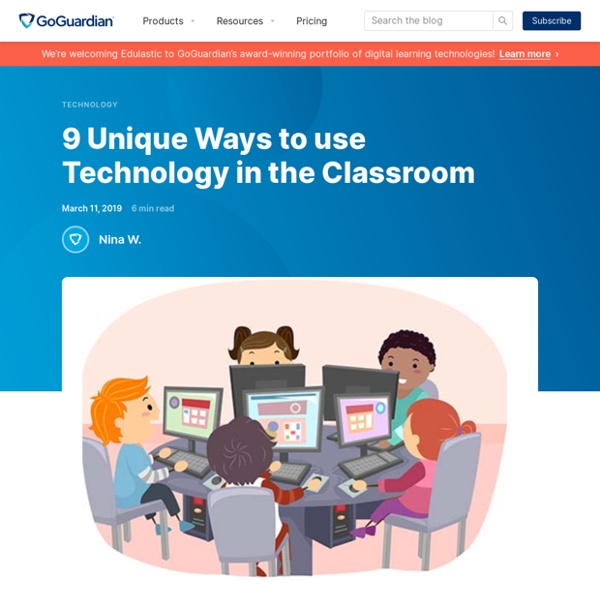How To Implement 1:1 (One-To-One) Technology In The Classroom
In recent years, we've seen an increase in the use of technology in schools. While many schools have seen such an increase, there is still a limited number of schools and districts that have implemented 1:1 technology in classrooms. In the article below, I'll share my thoughts about why providing technology for each student is something more schools should begin implementing. I'll also share some tips and suggestions for getting students, teachers, and classrooms ready for the use of 1:1 technology. Choosing The Right Technology Before you'll be able to give each student a piece of technology to use for learning, you first need to decide which pieces of equipment you'd like to use.
Instructional Technologies: Teaching Resources: Center for Innovative Teaching and Learning: Indiana University Bloomington
Learning technologies encompass a huge array of devices, software, web sites, campus-wide computing services, and cloud services, many of which can be accessed anytime/anywhere. From the more traditional podiums in classrooms that house computers, document cameras, and media players to social networking and social bookmarking sites, all sorts of tools and technologies are finding places in the world of teaching and learning. The most important thing to remember when using technology in teaching and learning is that learning outcomes come first.
Teachers' Essential Guide to Seesaw
What is Seesaw? And how are teachers using it? Learn more about this popular platform and how to use it with students. While Google Classroom and its accompanying suite of tools is immensely popular in education -- especially at the secondary level -- Seesaw is a fast-growing and user-friendly digital platform for teachers to assign work, engage with students, and provide feedback, among other classroom activities. It's also a standout choice for incorporating teacher, parent, and student feedback -- something not as easily achieved on Google Classroom.
Experts Weigh in on Key Considerations for K–12 1:1 Programs
Before implementing a one-to-one device program, school districts should have a well-structured integration plan in place, according to experts at the International Society for Technology in Education 2018 conference earlier this year. From training teachers to choosing the right network, bringing personal devices into the classroom is a lot of work. But, done correctly, there can be many rewards. Schools May Miss Important Internet Questions
Poorvu Center for Teaching and Learning
Greetings, Professor Falken: Why Use Technology? Why use technology? A legitimate question. There’s no doubt that technology cannot replace a good, real-life, sentient teacher, as anyone who’s ever tried to learn a foreign language online has no doubt discovered. But today’s undergraduates enter college with a high degree of computer literacy, and tapping into this trend by using various technological resources really can enhance classroom learning.
3 Minute Teaching TOOL-torials
Be sure to share these great resources with your friends and colleagues! Access all of these videos in this YouTube Playlist How to Add “Time Tags†to Youtube Vids (so Viewers can Jump to Tagged Sections)It’s Super Easy to Create These Simple ‘Bookmarks’ so Viewers Can Pop to Different Section of Your EdPuzzle 3 Minute TOOL-torial Add Questions to Videos, Monitor Progress, etc. EdPuzzle is an awesome free tool that makes it a breeze to embed questions in YouTube and Vimeo videos. When students log in and watch the videos on EdPuzzle, you can then see their progress.
5 Top Management Tips in the 1:1 Classroom
With 1:1 technology access now the norm, classroom management around devices is another piece of the planning. We hope these top 5 tips will help you to maximize learning while minimizing distractions in your technology rich, student-centered classroom. Focus on Relationships The beginning of any classroom management plan should start with building positive relationships with students. Teachers who do this well create healthy and focused learning environments.
How to use technology in the classroom - CAE Computer Aided E-learning
Technology in the classroom now plays a very big role in the effectiveness of education. Whether your students are five or fifty, it has become expected for teachers and tutors to utilise technology in order to better communicate course material. Many educational organisations offer courses that no longer need to take place in a traditional classroom.
The Latest Technology Used in Classrooms Today
The Latest Technology Used in Classrooms Today There are many new technologies being used in classrooms today: social networking, online teaching, class blogs and wikis, podcasting, interactive whiteboards, and mobile devices. There are many ways in which we can benefit from the new technologies being developed today. For one, new technologies make distance learning easier. It also allows for faster feedback and improved collaborative efforts between large groups of people.
Exploring STEAM Topics with Google Arts & Culture
When it comes to science education, Google Arts & Culture is brimming with possibilities. Previously known as the Google Art Project, this vast, interactive archive contains high-quality images, videos, and 360-degree views of artworks from around the world and across a huge array of partner institutions. You can even find fun virtual experiments and games to try. The Artist’s Perspective Visual art can be a great tool for engaging students of all ages, and can help build context and understanding across a range of subject areas, from history to language arts to the natural sciences and math.




This straightforward article provides nine easy ways to begin implementing technology into your classroom and explains the benefits to students. by daughertyc Feb 28